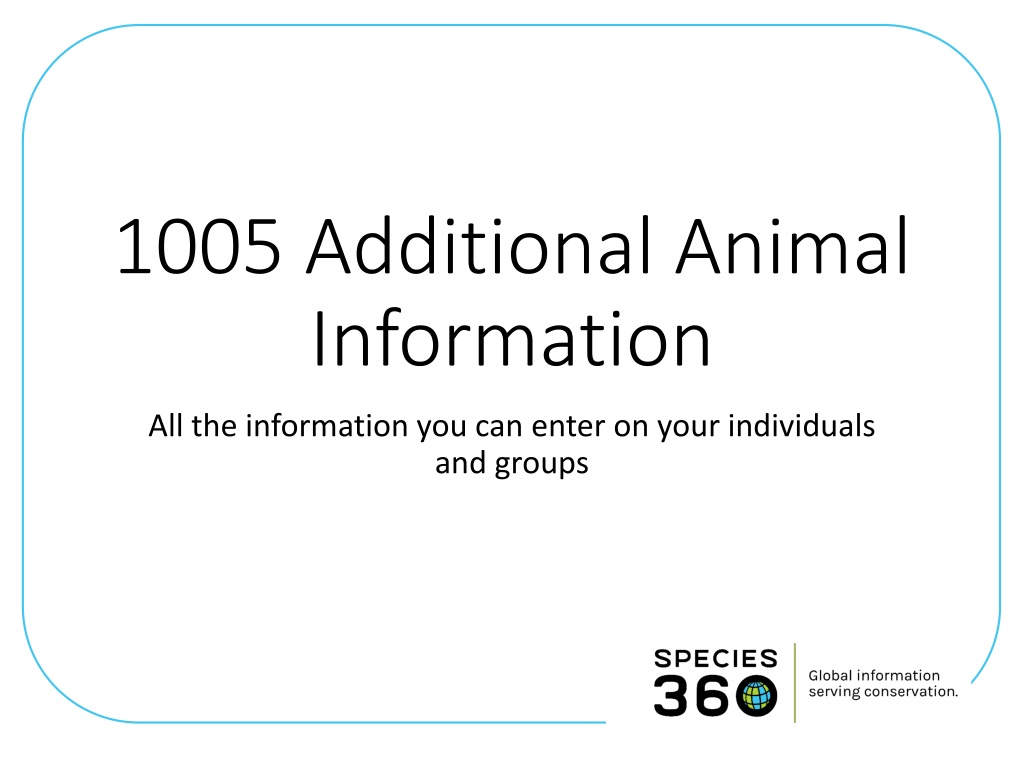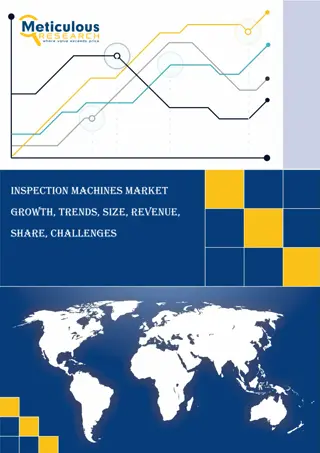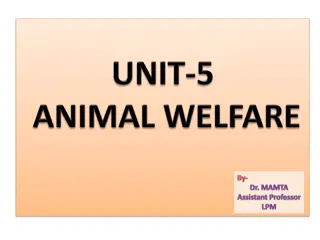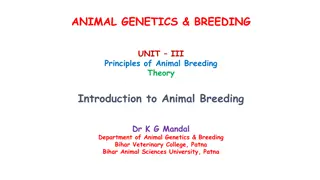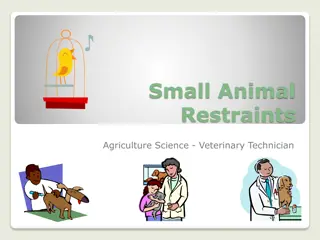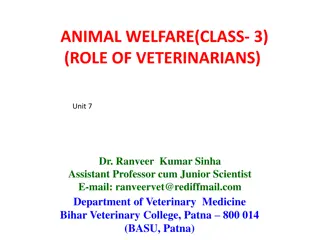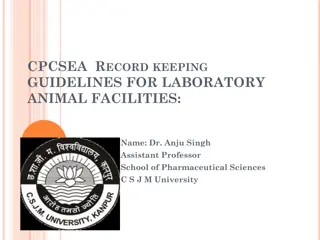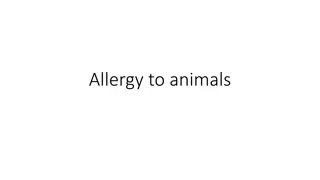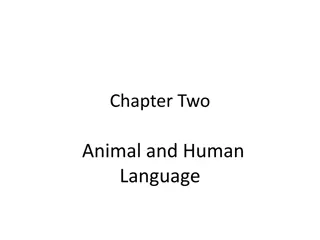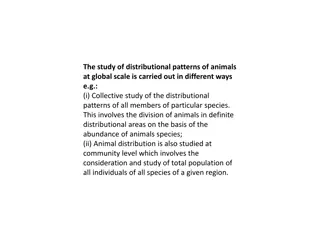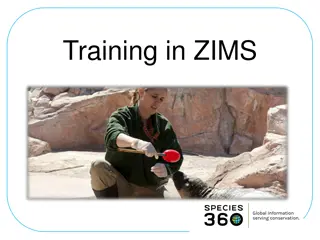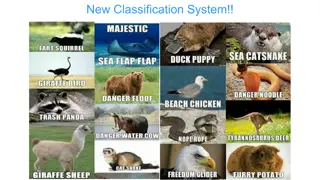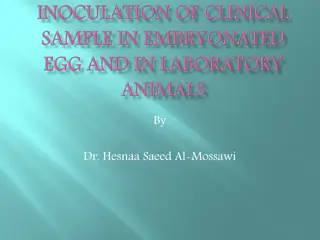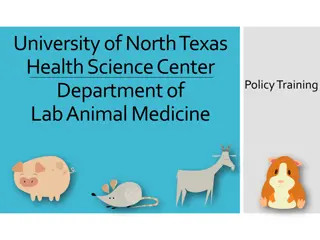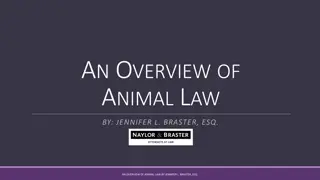Animal Information Management System Overview
Comprehensive details on managing individual and group animal information, including adding notes, observations, major life events, transactions, and basic info. Access physical holder and ownership transaction history for a complete record overview.
Download Presentation

Please find below an Image/Link to download the presentation.
The content on the website is provided AS IS for your information and personal use only. It may not be sold, licensed, or shared on other websites without obtaining consent from the author.If you encounter any issues during the download, it is possible that the publisher has removed the file from their server.
You are allowed to download the files provided on this website for personal or commercial use, subject to the condition that they are used lawfully. All files are the property of their respective owners.
The content on the website is provided AS IS for your information and personal use only. It may not be sold, licensed, or shared on other websites without obtaining consent from the author.
E N D
Presentation Transcript
1005 Additional Animal Information All the information you can enter on your individuals and groups
Tab-Note & Observation The Note & Observation tab is where you would add/edit/delete your notes and observations. Notes have a Date, Keyword option, Note Type and Sub Type in addition to the free text writing space. Observations have those fields but also allow you to capture more information such as the Observer, Duration and Quality of the Observation.
Tab-Major Life Event At the top of the animal record there is a tab titled Major Life Events. This is a quick view of major events for the animal. It includes transactions, sex changes and parent updates in addition to other life events if they have been recorded. Nothing can be edited from this tab, it is only for your information and the data is sourced from the specific topic grids in the animal record. It will include information that you have entered as well as information that other holders/owners have entered.
Tab-My Transactions The My Transactions tab is where you would enter all of the transactions or visits this animal has had with your facility. The green arrows on the left indicate incoming and the red arrows indicate outgoing transactions. The colored circles indicate if the transaction has been confirmed by the other institution involved if they are a Species360 member.
Details-Basic Info The Basic Info grid provides a brief overview of the animal in focus including the entity (individual, group, egg), the status (Alive or Dead, Open or Closed for a Group), all Local IDs assigned to it, species (hyperlink into taxonomy record), listing status, studbooks, birth location and type, age (as of today or date of death), current Collection and Enclosure (a hyperlink into the Enclosure record), and Health Status and Body Condition Score (both hyperlinks).
Details-Physical Holder/Ownership Transaction History The Physical Holder History and Ownership Transaction History grids compile all the information you have entered into My Transactions plus what other institutions have entered for their transaction history. You cannot edit anything from these grids it is simply for you to see the entire physical and ownership thread for the animal.
The Weights grid displays all weights recorded by all institutions. You can edit only those weights recorded by your facility. If a weight is sourced from the Medical module that is indicated by an icon. Any weights sourced from the Medical module cannot be edited or deleted from the Husbandry module and you must do so from the source record in Medical. You can also select to view a weight graph for the animal. Viewing the graph can help you monitor the animal s health and you can quickly see this animal is quickly gaining weight which could be good or bad. The graph also helps you see any incorrect Units of Measure that may have been recorded so you can correct them. There is also a Lengths grid where you can record various size measurements and create graphs similar to the weight graph. Details-Weights and Lengths
Details-Contraception The Contraception grid lets you enter various methods of contraception such as Animal Management and Medical (hormonal, immunological or surgical). You can have more than one method Active at a time. The details of the contraception are entered into the medical module but the actual contraception status is recorded here.
Details-Enclosures Record Current Enclosure Animal is in the enclosure you are moving it out of A Moved Out Date will be automatically entered in the Enclosure it left Record Historical Enclosure An enclosure move sometime before the animal was moved into its current enclosure You must record BOTH the Move In Date and the Move Out Date Allow Multiple Enclosure Assignment No automatic Move Out Date will be recorded for a Current move You need to indicate what Enclosures the animal is moved out of.
Details-External Sharing If your institution has turned on the ability to share a record with another institution the External Sharing grid will display what institutions the record is shared with, and what is being shared. This animal record is being shared with the Toledo Zoo and both Husbandry and Medical records are being shared. Only Husbandry records are being shared with Roger Williams Park Zoo.
Details-Identifiers The Identifiers grid allows you to record all the Physical (those you can see), Logical (those you cannot see) Identifiers as well as Transponders. Transponders are managed in an inventory from the My Institution module. All Identifiers at all institutions will be displayed but you can only edit or delete those added by your institution. If the animal has Identifiers recorded by other institutions that you want to record locally, this can easily be done by selecting to Accept as Local Identifier . This not only is a time saver but can help guard against data entry error by retyping.
Details-Parent Info The Parent Info grid captures the Parents and the percent probability that they are the Parents. Above, there were 3 females who could have been the Dam. If you are recording a Visit, the Parents will prefill and you do not have to re-enter them. If you are recording an initial accession you will need to complete this information during the accession.
Details-Rearing The Rearing grid lets you track the Rearing over time. The dam was neglectful of the calf from 23 November to 30 November so it was given supplemental feedings until the dam became more responsive. While Rearing is not a mandatory field in Husbandry, it is mandatory in Studbooks so try to record it whenever possible.
Details-Census Info (Groups only) The Census grid is available in Group records only. This is where you would record the count of the group members. In addition, any transactions recorded in My Transactions will be displayed here (red boxes). To change the tracking of a Group you will need to record a Census. A Census acts as a group count reset and any subsequent ins or outs of the Group will be added or subtracted from this number.
Details-Taxonomy/Sex Type/Collection This grid allows you to update the Sex, Taxonomy and Collection of the Individual animal. In a Group record this grid is Taxonomy / Collection and Sex is captured by tracking in the Census grid. As for all data, you can only edit/delete data entered by your institution.
Details-Alerts The Alerts grid allows you to assign future tasks or heads up relating to the animal. This Alert lets you know that the animal is scheduled for surgery and needs to be fasted. The Alert Text should be short and clear as this is what will display on the Calendar. You can set priorities from Urgent to Low and schedule times. On the Calendar you can quickly see that the animal needs to be fasted prior to surgery and the surgery is scheduled for 8:00 am on 27 August.
Details-Image You can attach photos to the animal record using the Image grid. Selecting Visible to all Species360 means that the image will be viewed Globally. Selecting Set as Profile Image means it will display in the Basic Info box. This can be very useful to make sure whoever is entering the data is in the correct record. Images can also be used to capture physical markings that help identify the animal.
More Details-Development Milestones Development Milestones are stages reached during development. Unlike Life Stages that have beginning and ending dates, Development Milestones have only the date when that milestone was reached and no updating is required when it reaches the next milestone.
More Details- Training Information The Training grid allows you to assign desired behaviors to an animal and track their learning by recording Sessions. In addition, you can track the Status of the Training from Planned to Completed.
More Details-Feed Logs The Feed Log grid allows you to track what was fed, how much was fed and how much was consumed. This is especially useful for tracking how much is being consumed for hand reared infants and individuals whose diet is being closely monitored for health reasons as well as for routine diet tracking.
More Details- Enrichment The Enrichment grid allows you to assign an Enrichment item to an animal and track the response to it by recording Sessions. You can capture the animal s reaction using a cascading drop down list as well as the success or failure of the Session.
More Details-Responsible Party How you use Responsible Parties is up to your institution. In the example below, a single person was responsible for the care and well being of the animal while it was going through quarantine. Once it was released from quarantine and put on exhibit, a Team then became responsible for it.
More Details-Birth/Hatch Date and Event Location Event Locations are usually sourced from information entered elsewhere. This animal had three events a hatch, it went missing (but was recovered) and then released to the wild. Some of these fields can be edited in this grid if entered by your institution. For example this is where you would edit a birth/hatch date for an animal you received from a member of the public. If the birth/hatch was the initial transaction you entered, trying to edit it here would take you back to the My Transactions screen to correct it. You can also add some information not captured elsewhere such as Conception Location and Capture Location for a wild caught animal that you received from someone else.
More Details-Permits You can use the Permits grid to assign any Permits you have received that relate to the animal. The actual Permits are managed under the My Institution module but you can also add a Permit from the Assign Permit grid using the hyperlink to open the Add New Permit grid.
More Details-Life Stages (Individuals only) The Life Stage grid is available only for Individual records. Life Stages in Groups are captured using the Census grid. Life stages have beginning and end dates whereas Development Milestones have a single reached at date. One thing to note about Life Stages should you choose to record them they must be manually updated. If you do not, you may have a 10 year old infant gorilla.
More Details-Management Plan The Management Plan grid allows you to track any managed programs the animal may be a part of. The Type is a short drop down of the status the animal is in the program. The Plan is a free text field so you should develop a convention for how to record it. The animal below was once a part of a green SSP program however it was later removed from the program. Use the notes to indicate why. You can search for animals in Management Plans under Animal Advanced Search options.
Additional Animal Information On all the information you can enter on your individuals and groups
